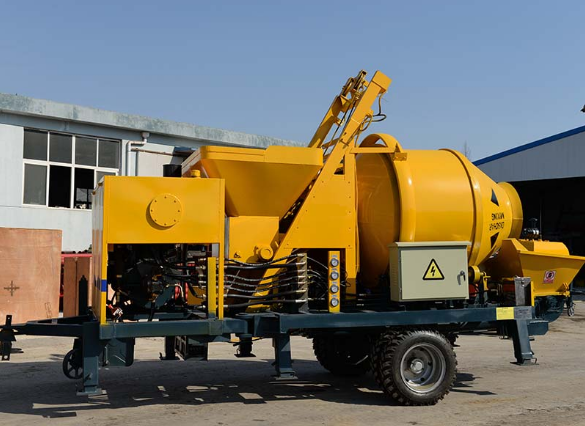How Does a Concrete Mixer Pump Work
A concrete mixer pump is a versatile and efficient construction machine used to mix and transport concrete to construction sites. It combines the functions of a concrete mixer and a concrete pump, making it an essential tool for various construction projects, especially those that require the timely and precise placement of concrete. In this detailed explanation, we will explore how a concrete mixer pump works and its key components and applications.
Components of a Concrete Mixer Pump:
Before delving into how a concrete mixer pump works, let's first understand its key components:
1. Concrete Mixer: This part of the machine is responsible for mixing the raw materials to create the concrete. It typically consists of a drum or container where the cement, sand, aggregate, and water are combined and mixed together. Some concrete mixer pumps have a twin-shaft or twin-drum design for enhanced mixing efficiency.
2. Concrete Pump: The concrete pump component of the machine is responsible for transporting the mixed concrete to the desired location. It typically consists of a series of pipes, valves, and a piston or rotary pump that pushes the concrete through the pipeline.
3. Hydraulic System: A hydraulic system is used to power both the mixer and the pump. It provides the necessary force to operate the machine's various components, including the drum rotation, pump movement, and valve controls.
4. Chassis: The chassis is the vehicle frame that supports and carries the entire concrete mixer pump. It includes the engine, wheels, and other components necessary for mobility.
How a Concrete Mixer Pump Works:
Now, let's explore the step-by-step process of how a concrete mixer pump works:
1. Mixing the Concrete:
The process begins with loading the raw materials into the concrete mixer's drum. Typically, cement, sand, aggregate (such as gravel or crushed stone), and water are added in precise proportions to achieve the desired concrete mix. The mixer's drum is then rotated, allowing the mixing blades or paddles inside to thoroughly combine the materials, forming a homogeneous concrete mixture.
2. Agitating the Concrete:
After the initial mixing, the drum continues to rotate at a slower speed to keep the concrete agitated and prevent it from settling or separating during transport.
3. Transporting the Concrete:
Once the concrete is mixed and agitated to the desired consistency, the next step is to transport it to the construction site. This is where the concrete pump component comes into play:
- The concrete pump is positioned near the construction site where the concrete needs to be placed. It consists of a hopper that receives the mixed concrete from the mixer's drum.
- A concrete pump typically uses a piston or rotary pump mechanism to create hydraulic pressure. This pressure forces the concrete through a network of pipes and hoses towards the delivery point.
- The operator can control the flow rate and direction of the concrete using valves and controls on the pump. This precision allows for accurate placement of the concrete in the desired location, whether it's in a foundation trench, on a building floor, or in a high-rise construction project.
4. Pouring and Placement:
As the concrete pump delivers the mixture to the construction site, it can be directed precisely to where it is needed. The operator can control the speed and direction of the flow, ensuring that the concrete is evenly distributed and properly placed in the forms or molds.
5. Continuous Operation:
The process of mixing, agitating, and pumping concrete can be continuous, allowing for efficient and rapid construction. This is especially beneficial in projects where time is of the essence, such as concrete pouring for building foundations, roads, or bridges.
Applications of Concrete Mixer Pumps:
Concrete mixer pumps are highly versatile and find application in a wide range of construction projects, including:
1. Building Construction: They are used for pouring concrete in various building elements, such as columns, beams, floors, and walls.
2. Infrastructure Projects: Concrete mixer pumps are employed in the construction of roads, bridges, tunnels, and other infrastructure projects.
3. High-Rise Construction: Their precise pumping capabilities make them suitable for pumping concrete to upper floors in high-rise buildings.
4. Residential Construction: Concrete mixer pumps are used in residential construction for tasks like pouring concrete for house foundations, patios, and driveways.
5. Remote or Difficult-to-Access Sites: They are valuable in locations where access is limited, such as remote construction sites or areas with challenging terrain.
Advantages of Concrete Mixer Pumps:
Concrete mixer pumps offer several advantages that contribute to their popularity in the construction industry:
1. Efficiency: They combine the functions of mixing and pumping, saving time and labor compared to traditional methods that require separate equipment.
2. Precision: The precise control of flow and direction allows for accurate placement of concrete, reducing wastage and improving construction quality.
3. Versatility: Concrete mixer pumps are versatile and adaptable to various construction scenarios and site conditions.
4. Cost Savings: Their efficiency and reduced labor requirements can lead to cost savings on construction projects.
5. Mobility: They can be easily transported to different construction sites, making them suitable for both large-scale and smaller projects.
In summary, a concrete mixer pump is a valuable machine that simplifies the process of mixing and transporting concrete on construction sites. Its ability to efficiently mix concrete and deliver it precisely to the desired location makes it an essential tool for a wide range of construction applications. Understanding how a concrete mixer pump works and its components is essential for ensuring its proper operation and optimizing its performance in construction projects.
If you want to know more information about concrete mixer pump, please click on the image below to get a free quote:















